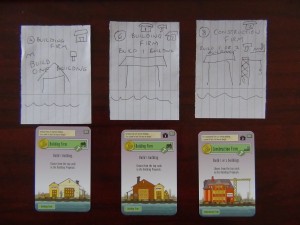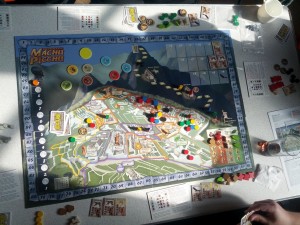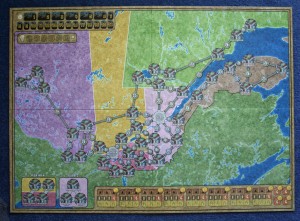Saturday was a special day on the Newcastle Gamers calendar. “Special” because it was the date marked for an ALL DAY gaming session. Well… perhaps — technically — not quite all-day, because it didn’t start until 10am. But it definitely went on after I left (midnight-ish)… and, lets face it, nothing worth doing ever happens before ten in the morning anyway.
Things seemed a bit problematic when I arrived. There was already a dozen or more early-bird gamers in attendance… but we only had TWO tables to play on. Unfortunately the store room which contains the venue’s supply of fold-away tables had been left locked, and nobody present had a key. Things could have turned nasty (I’m not as good at playing board games on the floor as I used to be) but fortunately whoever installed the cupboard doors did about a good a job of making it secure as the person who installed the patio doors at my old student flat… and within a short space of time we were fully furnished for an extravaganza of gaming!
A particularly hard-core contingent of gamers (not me!) promptly settled into a game of Twilight Imperium. Twilight Imperium is a long game. A really long game. A “brisk” game of Twilight Imperium runs for around 5 hours. A “proper” game, with lots of players? … well, it’s the sort of thing that you leave set up on your dining room table for a week, and play in easy-to-swallow instalments. I opted to leave them to it and play something a *touch* more brief.
John F. and Emma had got wind that I was bringing Le Havré to the meeting, and were keen to try it out. As we were setting up, Jonny landed at the table and asked if he could join – perfect. Three Johns and an Em — this ticks all the boxes on my previously-established “remembering the names of everybody you played a game with for blogging purposes” guidelines.
Thus began the first game of the day…
Le Havré
Warning: May contain gratuituous gender stereotypes
I like Le Havré. It is — empirically, at least — my second favourite board game of all time (check my board game geek ratings for the statistical proof). Unfortunately, it takes quite a while to play. I mean, it’s nowhere near as long as Twilight Imperium… but it still occupies the best part 4 hours on most occasions (particularly when played with first-timers), so it doesn’t get an outing nearly as often as it might. It was, therefore, great to get an opportunity to give it an airing — it had been months since my last game.
Imagine, then, my sense of despair when I finally got the game out on a table, sit the bits up, and discovered that three critical components were missing! I searched, and re-searched the box… but there was no sign of the three starting buildings.
But… you know what’s great about having girl gamers in your gaming group? Well — actually — there’s a whole lot of great things about having girl gamers in your gaming group, but one of them is this:
If you have a room full of guys playing a game, and you’re all away from home, and you ask a question like: “Hmmm… I don’t suppose anybody here has a sheet of paper, do they?” … then you’re *probably* going just get a few shrugs, and a shuffling of feet in response. Maybe an offer of a crumpled cigarette box if one of them happens to be a smoker. Or a beer mat if you’re in a pub. But … generally … your chances for a positive outcome are NOT high. We, as a gender, tend not to be prepared for eventualities like that.
Emma, on the other hand, had paper. She also had a choice of *types* of paper. Would I like lined paper, or blank paper? And what type of pen? Awesome.
Witness, then, my desperate attempt to save the day. Entirely improvised starter cards… (alongside the “real” cards, which I fortunately managed to un-lose the next day):
Magnificent, no?
Yeah.. well, it was good enough to get us up and running, and a most excellent game of Le Havré was had by all. It was perhaps a little bit different from a typical game, insofar-as Iron-handling buildings made a comparatively late debut, so there wasn’t much of a grab for iron/steel ships (in fact, I’m not sure any steel was made in the game at all)… We were also playing with the Grand Hammeau special buildings deck, and it threw out some of the most oblique/un-useful cards in the whole set (it would maybe have given a better feel of the game’s potential if something like the fur trade, or cobbler, or hide trader had come out… since in lieu of steel, the game’s supply chain had become quite bovine-focussed).
However, part of the fun of Le Havré is that although the card sequence is pre-stacked to an extent, it’s done in a way that often tilts the game in a slightly unpredictable way. This goes a long way towards preventing the game getting stale after a few plays… and I’m sure everybody got a sense of that, despite the quirks of this particular game.
Food break!
One game down… and it was already nearly 2pm; where was the day going? Why wasn’t I hungry??? A quick dash across the road to grab some food from Sainsburys seemed sensible. (Though I found myself standing, staring at the “£3 meal deal” instructions for an inordinately-long period of time. I was looking at the words… but the instructions just weren’t going in. I blame 3-and-a-half hours of concentration on Le Havré for that. If they had little Klemens Franz illustrations of fish, and “2x” arrows, and sandwiches, I would’ve been much happer).
Lunch in hand, I dashed back to the hall to take my previously-reserved place alongside Steve, John F, Jonny and Jerome on a game of…
The Princes of Machu Picchu
I’ll skip too much detail on this one, because we played it incorrectly. Or rather, we played it incorrectly for about 80% of the game, by which point the damage was done; we’d all been aiming for victory conditions that were largely divorced from the game’s actual victory conditions, and by the time the problem was identified, it was (a) too late to get back on track, and (b) obvious that the scoring system that we _thought_ we were originally using was so off-kilter that the final results would be nonsensical. So … we finished the game, but then scored it the “correct” way.
Oh well. it was a learning experience, and at least gave a flavour of how the game works. ‘Nuff said.
Village
No picture of this one… but I’ve posted Village reports so many times now that you’re probably sick of reading about it. I don’t think there was anything particularly unusual about this session… I played an early-death / travelling the world / merchant tactic. Though — of course — travelling the world and ending the game through early deaths is probably _not_ the most viable combo… oops.
I’ve taken Village to every meeting for a couple of months now… (and taught/played it on every occassion) …it’s a really enjoyable game, but it’s possibly time to rest it for a while and fit something else into my gaming bag. I think I might try pimping Hawaii in its place next time 😉
Power Grid: Quebec
This is my most recent gaming acquisition — a new map for the perennial Newcastle Gamers favourite, Power Grid. I only got it a few days ago, so was keen to give it an inaugural play. John F, Emma, Andrew, Jerome and Steve were happy to oblige … with Emily sitting in on the session to handle the bank and help out first-timer Andrew.
I really enjoyed this map. It has a couple of odd quirks — notably, the layout of the “city centre” clusters of Montréal and Québec … and an odd auction tweak which makes eco energy plants more predominant.
In the opening auction, I managed to grab the 03 power plant and get first choice of building location — so snarfed all 4 spots of Montréal. I was then somewhat surprised to grab a 2-city eco plant in the second auction (I was sure people would try to bid me out of that!), which gave me a very strong start. I floated around the front of the player order for most of the game, but didn’t feel quite as punished by the position as I normally do in a game of power grid… but, sadly, I misjudged the point where the game turns from a marathon into a sprint; I _thought_ I’d have one more turn to execute my master plan and hit 15 or 16 cities in single move… but Jerome and Steve linked out to a game-ending 14 cities faster than I expected, and all I could power was 13. The game ended on a tie-break of 7 electros between the two of them. Nail-biting stuff.
The game seemed an awful lot more balanced than I thought it might be, given the odd layout of the map (we attracted one or two Power-Grid-experienced spectators during the course of the game, who all raised an eyebrow at the somewhat-unconventional layout). Of course, I might have a somewhat biased viewpoint, since I got a good starting position … but I liked this one a lot. And I guess the fact that Québec was originally published as the flip-side map in the French-language edition of Powergrid — “Megawatts” — suggests that it’s been pretty well play-tested / had any wrinkles ironed out of it.
By the time we wrapped up powergrid, it was creeping towards 10pm… and — having clocked up 12 hours of board game plying — I was starting to wonder if it was maybe time to head off home…
Wondering — that is — until John F. pulled something new and tempting out of his bag… 🙂
Principato
I’ve never heard of Principato before — a fact which I found to be a little bit odd. I mean… I don’t claim to be a walking encyclopedia of board games or anything like that, but I’ve usually at least vaguely heard of the stuff that gets played at Newcastle Gamers… and particularly the kind of stuff that looks like the sort of stuff I like playing. Principato _definitely_ looked like the sort of stuff I like playing.
It’s a pretty straightforward euro; collect wooden cube resources (food / money / favour from the church), use them to build up your principality, and score victory points. Nothing exceptional so far. However, Principato has quite a neat/unusual mechanism at its core…
Each player is dealt a pair of cards, depicting two possible actions. These include options like adding a food-generator (farm) to your board, build money-storage buildings (banks), add to your city wall fortifications (catapults!)… etc. There’s also a pool of 7 cards in a central area. The card pool works a bit like a conveyor belt; each turn a card disappears from the left-most end of the pool to a discard pile (never to be seen again), everything shuffles down one space, and a new card is added to the right-most end of the pool. A player’s turn comprises various combinations of either taking an action on one of the cards that you’re currently holding, and/or swapping one of your cards for something on the “conveyor belt”.
The game proceeds in 3 phases, with a specific stack of cards feeding into the pool for each phase … you play through the initial stack of cards (which tends to contain actions for developing your basic resource-production facilities), and at the end of that stack, there’s a “battle phase”, in which whatever players have built up the best fortifications get victory points. Then you work through another stack which has stuff from the first “era”, plus additional cultural artifacts — at the end of the second age there’s another battle for victory points… and then a third stack of cards and…
…you know what? This game seems a lot like somebody took the rules for 7 wonders, put them through google’s English-to-Japanese translation service, translated them back to English again, and then made a new game out of the results. Seriously. But it’s actually a much, much better game than 7 wonders, IMHO.
There are some interesting subtleties… if you don’t want to use a card right now, but want to keep it in the pool to pick up again later, you can drop it at the right hand end of the “conveyor” and hope it’ll still be working its way down the line when you get your next turn. Conversely, if you want to deny a particular action to your opponents, you can pick it up and dump it at the left hand end (where it’ll get junked after your turn). Clever!
It’s a difficult game to play on your first attempt… firstly, it’s easy to fall into the trap of thinking that winning the battle phase is more important than it actually is (which isn’t necessarily true … just like 7 wonders, you can forsake the battles and work towards a cultural victory instead) — and not knowing how the balance of cards changes between eras can make long term planning for your (secret mission) objectives tricky. For example, I had an objective card that would give me points for lots of farms, but I didn’t realise how the availability of farms would change as the game progressed. However, that’s the kind of thing that you can only really learn from playing the game, and experiencing its pacing first-hand.
I enjoyed this one… it was my second favourite of the day, after Le Havré. It’s maybe not something I’d rush out and buy my own copy of, but it was certainly a neat little euro that I’d happily play again.
However, I was still a bit mystified by how this game managed to fly under my radar for so long, and the designer’s name wasn’t ringing any bells… so I checked out it’s details on Board Game Geek the next day.
It would appear that designer Touko Tahkokallio might have released another, ever-so-slightly more prominent game in the same year. The success of which might have eclipsed Principato just a tiny, tiny bit.
Hmmm. “eclipsed”. Do you see what I did there? 😉
And so to bed…
Principato ran on slightly longer than anticipated — I think it was about 11:45pm when we finished — and so, after almost 14 hours of gaming, I said my goodbyes and left for home. At the start of the day, I had wondered if the meeting would turn into a bit of a marathon / mental endurance test, and start to drag … but the whole day flew past. Great games, great people (39 this time; a club record!) — I can’t think of a better way to spend a lazy Saturday!
The trip home was a nightmare (the road I usually take was closed for overnight roadworks – ugh!), and the muscular after-effects of sitting on non-ergonomic chairs for far-too-long-at-a-time hit me at about 3 in the morning (double ugh!) … but otherwise, the day was excellent in all respects.
I’m slightly surprised that I only managed to fit in 5 games, since I had very little down-time between them. Le Havre is, of course, a somewhat longer one … but I guess the others were averaging 2 hours each, and when you factor in some overheads for explaining rules, grabbing food etc it all fits. I’m slightly disappointed that I didn’t get to play Hawaii this session (it’s reputation has preceded it… or, rather, the reputation of Tom Vassel’s controversial video review has preceded it — he’s got a lot to answer for on this one!!!) …
However, there’s always next time… 🙂
Oh… and that game of Twilight Imperium that I mentioned? It ran for 11 hours in the end … check out Olly’s game report on the G+ group for all the gory details.
CREDITS:
The pictures were taken by Olly, and have been gratuitously stolen from the Newcastle Gamers Google+ Group. Newcastle Gamers meets on the second and last Saturday of the month… usual cost is £3 (or £1 for concessions), but your first visit is free. Check the G+ group for more info.






 Follow
Follow
Pingback: Newcastle Gamers – 8th September 2012 | John's bit of the web